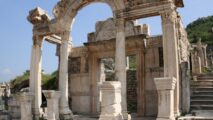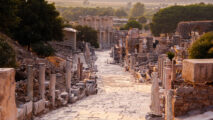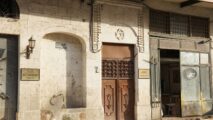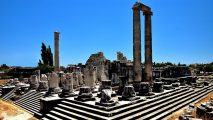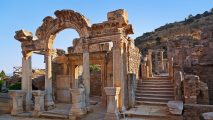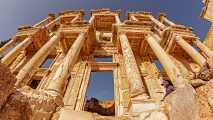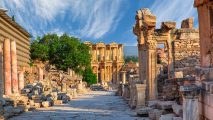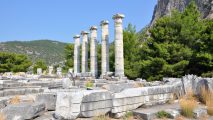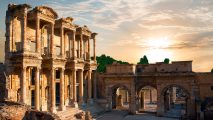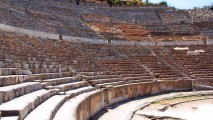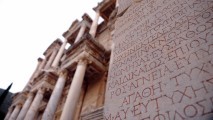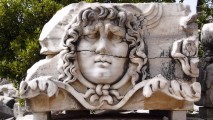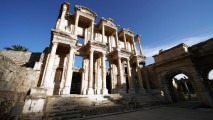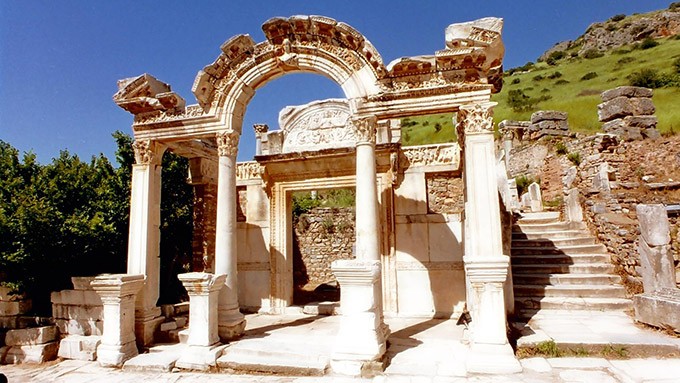
Explore the Mysteries of Ephesus: A Journey into Antiquity with Expert Tours
Embark on a captivating exploration of Ephesus, a city steeped in history and mythology, nestled an hour away from the city of Aydin. Ephesus, once inhabited by the Carian and Lelegean tribes, was believed to be founded by the Amazons, named after their queen, according to the ancient historians Strabo and Pausanias.
In the 1040s BC, the region, fragmented by linguistic and cultural divisions, saw Ephesus transform into a Greek colony by the 10th century BC. Legend has it that the city’s establishment was guided by an oracle from Delphi, fulfilled when Androclos, son of the Athenian King Kodros, followed a prophecy involving a fish and a boar to the banks of the Kaistros River. There, the founding of Ephesus at Mount Coressos marked a new chapter, with the city prospering under Ionian influence for 44 years.
Despite enduring a Cimmerian siege in the 7th century BC, Ephesus rose to prominence, partly due to the fame of the Temple of Artemis, a marvel of the ancient world. However, Persian conquests and the Ionian revolt reshaped its fate until Alexander the Great’s arrival in the 3rd century BC, initiating a golden era of prosperity and architectural grandeur, including the construction of significant city walls.
The Roman annexation in 130 BC heralded Ephesus as the capital of Asia Minor, further elevating its status as a commercial hub. Yet, the Gothic invasion in 262 AD marked the beginning of its decline, with the Temple of Artemis being notably plundered.
Christianity’s rise saw the transformation of Ephesus’s spiritual landscape, replacing Artemis worship with the veneration of the Virgin Mary, evidenced by the establishment of the first church dedicated to her.
The Temple of Artemis: The Ephesian Artemis, evolving from the ancient Anatolian “mother goddess,” was honored in a temple celebrated as one of the Seven Wonders of the World. In its 6th-century BC golden age, Ephesus saw the construction of this grand edifice, which faced destruction and reconstruction over the ages, including being burnt down the night of Alexander the Great’s birth.
The State Agora: Entering Ephesus through the Magnesia gate reveals the expansive State Agora, dating back to the first century BC, and later augmented by Emperor Theodosius. This agora was the city’s political and social heart, surrounded by significant structures, including a basilica and various baths that evolved through Roman and Byzantine influences.
Odeion and The Prytaneion: The Odeion, built around 150 AD by Publius Vedius Antonius and his wife, served dual functions as a concert hall and council chamber. Nearby, The Prytaneion, established in the 3rd century BC and reaching its final form under Augustus, was a focal point for the city’s administrative and religious activities.
Ephesus remains a testament to the glories of ancient civilizations, inviting modern explorers to wander through its ruins and relive the narratives of its past. From the grandeur of its temples and agoras to the intimate spaces of its baths and council chambers, Ephesus offers a window into a world where history and mythology intertwine. Discover Ephesus and immerse yourself in the legacy of one of antiquity’s most influential cities.
Domitian Square and Pollio Fountain: In the heart of Ephesus, Domitian Square unfolds as a testament to the city’s rich history, adorned with artifacts that echo its past splendor. Among these, a round pedestal, embellished with garlands and originating from the 4th century AD, marks a significant find, alongside a triangular relief of Nike, which adorns the Heracles Gate. The square is flanked by remnants of a once-monumental gate, leading to the impressive Pollio Fountain. Positioned at the edge of the State Agora and facing Domitian Square, the fountain, with its commanding arch and semicircular exedra, once fed a pool where the statue of Odysseus proudly stood, parts of which now reside in the Ephesus Museum.
The Temple of Domitian: The Temple of Domitian, erected in honor of the emperor who rose from the esteemed Flavius family in 81 AD, serves as a stark reminder of his transformation from a just ruler to a despot who proclaimed himself “master and god.” The discovery of a massive statue of Domitian, comprised of the head and an arm, underscores the temple’s dedication to him. The structure’s facade, facing the square, reveals well-preserved storerooms, attesting to the temple’s historical significance. Inside the Ephesus Museum, an altar from the temple showcases the intricate artistry of the era, with limestone bases and marble tops carved with figures that symbolize Domitian’s lineage, including Memmius, his father Caius, and grandfather Sulla.
Curetes Street: Stretching from the Celsius Library towards the confluence of Mounts Panayir and Bulbul, Curetes Street serves as a grand avenue, paving the way from the State Agora to the Heracles Gate. Adorned with white marble and lined with columned galleries featuring decorative mosaics, this street was once the city’s main thoroughfare. Statues of notable figures once graced the spaces between columns, their pedestals enduring as silent witnesses to the past. Named after a myth involving Zeus, Leto, and their daughter Artemis, Curetes Street honors the Curetes, semi-deities who played a crucial role in safeguarding the newborn goddess. This revered priestly class, initially connected solely to the Artemission, eventually extended their influence to the Prytaneion, symbolizing the sacred fire of Hestia and embodying Ephesus’s spiritual heritage.
The Trajan Fountain: Constructed between 102 and 114 AD, the Trajan Fountain stands as a tribute to Emperor Trajan, revealed through inscriptions on a distinguished cornice. This architectural marvel featured a “U”-shaped design with two tiers of columns and a central niche that once housed a majestic statue of Emperor Trajan himself. A wide channel beneath the statue allowed water to cascade into the pool, showcasing the fountain’s impressive scale. After undergoing meticulous restoration, the Trajan Fountain has been reinstated, continuing to captivate visitors with its ancient splendor.
The Skolastikia Baths: Located on Curetes Street, near the Trajan Fountain, the Skolastikia Baths were Ephesus’s most extensive bath complex, dating from the 1st to 2nd centuries AD. Under the guidance of Christian Skolastikia in the 400s AD, the baths saw significant renovations, expanding to a three-story structure with dual entrances—one facing Curetes Street and another leading towards the Grand Theater. A section of mosaic flooring offers a peek into the original decor, while the adjacent Latrina, the city’s public toilets, showcases Ephesus’s advanced sewage system, complete with a square pool, stone commodes, and a sophisticated waste disposal system.
The Temple of Hadrian: The Temple of Hadrian, an exquisite structure on Curetes Street, is dedicated to the Roman Emperor. Its design features a monumental Pronaos and Naos, adorned with a relief of Tyche, the city goddess, at the pinnacle of the arch. The temple’s entrance is beautifully decorated, flanked by friezes that recount the founding of Ephesus, including scenes of Androclos, the city’s founder, in a mythological hunt. These artistic elements, drawn from various periods of Ephesus’s history, underscore the temple’s significance and aesthetic appeal in the ancient city.
Terrace Houses: Nestled on the slopes opposite the Temple of Hadrian, along Curetes Street, the Terrace Houses epitomize the opulence of ancient Ephesian society. Often referred to as the “rich houses,” these residences, unearthed through meticulous excavations, reveal the grandeur of their past inhabitants through colonnaded porticoes, direct access via step streets, and multi-story layouts where daily life unfolded on the ground floors and bedrooms occupied the upper levels.
Innovative water channels and wells ensured a constant supply of water, while an advanced heating system through earthenware pipes warmed these homes. The interiors were adorned with vibrant frescoes depicting animals, mythological scenes, and everyday life, dating back to the 1st century AD. Restoration efforts have revived two of these magnificent dwellings, offering a window into Ephesus’s affluent past.
House A and B: House A, spanning 900 sq. m., features a mosaic-floored hallway, marble floors, and a unique “theater room” adorned with 2nd-century AD frescoes. House B, distinguished by its two peristyles and sophisticated decor, boasts a cistern, a fountain, and exquisite black and white marble mosaics portraying mythological scenes.
The Brothel: Adjacent to the Skolastikia Baths, the brothel was initially a peristyle house. Serving various purposes from the Emperor Trajan’s era to the 7th century, its central chamber, highlighted by mosaic floors, was a focal point for social gatherings, showcasing the multifaceted nature of ancient Ephesian society.
The Celsus Library: The Celsus Library, a testament to Roman architectural finesse, was established as a mausoleum for Jelius Celsus Polemanus by his son, Tiberius Julius Aquila. Its facade, a symphony of columns and sculptures representing virtues, masks a singular spacious hall within. Despite Gothic invasions, the library’s facade endured through centuries, symbolizing the intellectual and cultural achievements of ancient Ephesus. Restored in the late 20th century, it stands as one of Ephesus’s most iconic structures.
The Mazeus-Mitridates Gates and the Agora: Flanking the esteemed Celsus Library, the Greek-Roman triumphal arch, known as the Mazeus-Mitridates Gates, ushers visitors into the commercial agora, an ancient marketplace dating back to the 4th or 3rd century BC. An inscription, once in gold-plated bronze letters, commemorates its construction by Mazeus and Mithridates, freedmen of Agrippa, in honor of Emperor Augustus and his family. This gate, with its three-sectioned attic and arched passages, showcases the lavish architectural style of the era, leading into an agora surrounded by storerooms and covered porticoes, revealing insights into Ephesus’s bustling trade activities.
The Marble Road: The Marble Road, stretching from the Artemision to the Vedius gymnasium and beyond, served as Ephesus’s central artery, circling Mount Coressos. Paved in white marble by Eutrophios, this road connected key city landmarks, including the grand theater and the agora. Its elevated design facilitated a sewage system underneath, with a Doric Stoa and colonnaded sidewalks marking the journey towards the theater. Impressions of carriage wheels evidence the road’s use for transportation, hinting at the unexplored historical treasures along its path.
The Grand Theater: A Cultural Powerhouse The Hellenistic-era grand theater of Ephesus, expanded during the Roman period, could host 24,000 spectators, making it a focal point for the city’s social and cultural events. The theater’s elaborate stage building, adorned with columns, niches, and statues, underscores the architectural and artistic sophistication of ancient Ephesus. This venue, transitioning from theatrical plays to gladiatorial contests, encapsulates the diverse entertainment that once thrived within its walls.
The Harbour Street: Harbour Street, or the Arcadian, stretched from the theater to the harbor, defined by a marble pavement and flanked by stores and colonnaded sidewalks. Built and repaired by Emperor Arcadius, this street ended at a monumental harbor gate, illustrating Ephesus’s prominence as a port city. Despite the river’s alluvium gradually rendering the harbor unusable, recent excavations in the area continue to unveil Ephesus’s rich history, offering new insights into its past glory.
The Church of the Virgin Mary Perched on Mount Bülbül, the House of the Virgin Mary is a sacred site in Christianity. Tradition holds that before his crucifixion, Jesus Christ entrusted St. John with the care of his mother, Mary. Following this, St. John brought Mary to Ephesus, where she lived in seclusion until her death. This site is distinguished as the first church in Asia dedicated to the Virgin Mary. The third Ecumenical Council, convened in Ephesus in 431 AD, affirmed Mary’s role as the mother of Jesus Christ, acknowledging her divine and human nature, amidst the foundation of a church that celebrated her life and passing.
The Church of St. John St. John, who accompanied the Virgin Mary to Ephesus, became a pivotal figure in spreading Christianity following St. Paul’s martyrdom. Initially built in the 4th century on Ayasuluk Hill, the site of St. John’s burial, the church was later replaced by a grand basilica during Emperor Justinian’s reign, reflecting Ephesus’s architectural heritage. To safeguard against invasions, fortifications were erected, with the main entrance through the robust Pursuit Gate. Despite its ruins, the Church of St. John remains a significant pilgrimage site, with ongoing restorations preserving its legacy.
Isa Bey Mosque Constructed in 1375 under the Seljuk Dynasty, Isa Bey Mosque stands as a prime example of Anatolian columned mosques. Located at Ayasuluk Hill’s base, near the Church of St. John, this mosque once featured an arcade courtyard and a mosque chamber with a double-domed roof, supported by intricately decorated granite columns. Today, remnants of its architectural splendor, including one of its original minarets, continue to captivate visitors.
The Cave of Seven Sleepers This legendary site narrates the tale of seven Christian youths who sought refuge from persecution under Emperor Decius in a cave on Mount Coressos. Miraculously sleeping for centuries, they awoke to find Christianity flourishing. Emperor Theodosius II’s visit cemented the cave’s status as a holy site, transforming it into a Christian cemetery and pilgrimage center. The basilica amidst the cemetery and the legendary graves of the seven sleepers remind us of this enduring legend.
The House of Virgin Mary Despite extensive research, the life of the Virgin Mary remains shrouded in mystery, with a deliberate effort on her part to lead a secluded life. Entrusted to each other by Jesus Christ before his crucifixion, St. John and the Virgin Mary were committed to fulfilling his final wishes. Historical records, including those by Eusebio, suggest that St. John brought the Virgin Mary to Ephesus around 42 AD. This period of their lives is documented in the Gospel of St. John and writings from the 1st to 6th centuries. The 431 AD Ecumenical Council in Ephesus, declaring the Virgin Mary as the Mother of God, supports the belief that she lived and ultimately passed away in Ephesus. The Virgin Mary’s final residence, discovered following descriptions by Anna Katherine Emmerick, has since become a revered Christian site, further authenticated by papal visits in the 20th century. This deep connection between the Virgin Mary and Ephesus underscores the spiritual significance of the location.
Ephesus Museum The Ephesus Museum, established in 1929, safeguards artifacts from Ephesus and its environs, with only a fraction of the ancient city unearthed so far. Despite early finds ending up in European museums, the museum’s collection has grown, especially after the 1964 and 1976 expansions. Today, it houses significant finds from Ephesus, the Church of St. John, and other ancient locales, meticulously documented and preserved for public display or careful storage.
Sirince Village Sirince, an ancient Greek village near Selcuk, is prized for its natural defenses, fertile lands, and historical architecture, drawing a blend of tourists and retirees. Known for its wine production and charming accommodations, Sirince reflects a blend of historical preservation and modern allure, making it a unique destination within the region.
This journey through the Sanctuary of Virgin Mary, the Ephesus Museum, and Sirince Village offers a glimpse into the spiritual heritage, archaeological wealth, and rural charm of the Ephesus area, inviting exploration and reflection on its deep historical and cultural layers.

